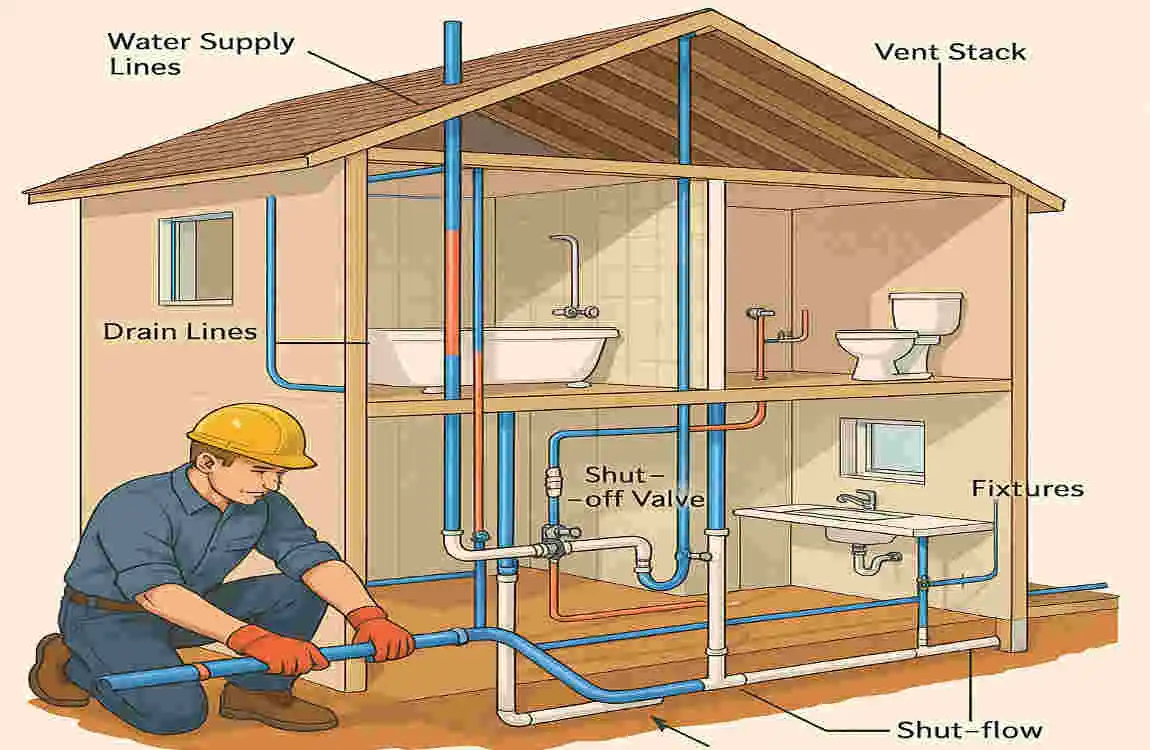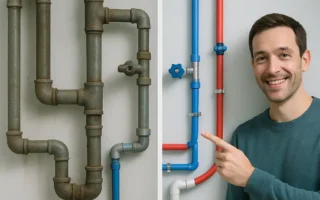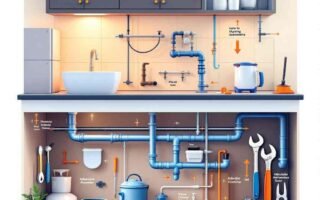Installing plumbing in a new house is one of the most critical aspects of home construction. A well-planned and properly executed plumbing system ensures that your home has a reliable water supply, efficient drainage, and functional fixtures. Whether you’re building your own home or overseeing the construction process, understanding how to install plumbing in a new house is essential.
From understanding the basics of house plumbing systems and gathering the right tools to planning layouts and executing the installation, you’ll find everything you need to know here. Along the way, we’ll share key tips, safety measures, and common mistakes to avoid.
Understanding Plumbing Basics

Before diving into the details of installation, it’s important to understand the basic components and systems that make up a plumbing system. This foundational knowledge will help you navigate the process smoothly.
What Is Plumbing?
In simple terms, plumbing involves the system of pipes, fixtures, fittings, and appliances that distribute water and remove waste from a building. A well-maintained plumbing system ensures a clean water supply and proper disposal of wastewater.
Key Components of a Plumbing System
Here are the main components of a plumbing system in a new house:
- Pipes: These transport water to and from different areas of the house.
- Fixtures: Items like sinks, toilets, showers, and bathtubs that you use daily.
- Fittings: Small parts, such as elbows, tees, and couplings, that connect pipes.
- Drains and Vents: These remove wastewater and allow air to circulate through the drainage system.
Types of Plumbing Systems
There are two primary plumbing systems in any home:
- Water Supply System: This delivers clean water to the house through a network of pipes.
- Drainage System: This removes wastewater and ensures proper sanitation.
Common Plumbing Materials
Different materials are used in plumbing, each with its pros and cons:
MaterialProsCons
PVC: Lightweight, affordable, easy to install. Not suitable for hot water
Copper Durable, heat-resistant, long-lasting Expensive, harder to install
UV rays Can damage PEX Flexible, resistant to freezings
When planning how to install plumbing in a new house, it’s crucial to choose the right materials based on your budget, climate, and local codes.
Importance of Planning
Proper layout planning is crucial to ensure that your plumbing system is efficient and compliant with building codes. A poorly designed system can lead to leaks, backups, and costly future repairs.
Tools and Materials Needed for Plumbing Installation
Before starting the installation process, you’ll need to gather the necessary tools, materials, and safety gear. Having the right equipment will make the process smoother and help avoid unnecessary delays.
Essential Tools
Here’s a list of tools you’ll need:
- Pipe Cutter: For cutting pipes cleanly.
- Wrench Set: To tighten and loosen fittings.
- Teflon Tape: For sealing threaded pipe connections.
- Pipe Bender: Useful for shaping metal pipes.
- Plumbing Snake: Helps clear clogs in pipes.
- Measuring Tape: Ensures accurate pipe measurements.
Required Materials
You’ll also need the following materials:
- Pipes: Choose from PVC, copper, or PEX based on your needs.
- Fittings: Such as elbows, tees, and couplings.
- Valves: To control water flow.
- Sealants and Adhesives: Ensure leak-proof connections.
Safety Gear
Don’t forget to prioritize safety! Use:
- Safety goggles
- Gloves
- Dust masks (when working with certain materials)
Where to Source Materials
You can find quality plumbing tools and materials at home improvement stores, specialized plumbing shops, or online retailers. Look for trusted brands to ensure durability and reliability.
Planning Your Plumbing Layout for a New House

Planning your plumbing layout is a critical step in the installation process. A well-thought-out plan ensures that your system is efficient, code-compliant, and cost-effective.
Reading Blueprints and Schematics
Start by reviewing your house’s blueprints and plumbing schematics. These documents will show you the location of walls, fixtures, and water supply points. If you’re unsure how to interpret the plans, consult a professional.
Determining Water Supply Points
Identify where your water supply will enter the house. Plan the placement of key fixtures like sinks, toilets, showers, and appliances (e.g., washing machines). Ensure that these points are easily accessible.
Designing Drainage and Venting Systems
A proper drainage and venting system is essential for removing wastewater and preventing sewer gases from entering your home. Plan for the following:
- Drain Pipes: Ensure proper slope for effective drainage.
- Vent Pipes: Allow air to flow and prevent water traps from being siphoned.
Local Code Compliance
Check with your local building department to ensure that your plumbing layout meets all regulations. You may need permits for certain aspects of the installation.
Tips for Efficient Layout Planning
- Keep pipe runs as short as possible to save on materials and reduce water pressure loss.
- Group fixtures together to simplify the layout.
- Plan for future expansions, such as adding a bathroom or outdoor faucet.
Step-by-Step Plumbing Installation Process
Once your layout is ready, it’s time to begin the installation. Follow these steps carefully to ensure a successful plumbing system.
Preparing the Site
- Clear the construction site and mark the pipe routes.
- Use chalk or spray paint to mark the locations of fixtures, pipes, and connections.
Installing the Main Water Supply Line
- Lay the main water supply pipe from the municipal connection to your house.
- Use a trenching tool to dig a proper channel for the pipe.
Laying Out Waste and Vent Pipes
- Install drain pipes for each fixture, ensuring the correct slope.
- Connect vent pipes to allow air into the drainage system.
Installing Water Pipes for Fixtures
- Run water supply lines to each fixture.
- Use pipe clamps to secure the pipes in place.
Connecting Fixtures and Fittings
- Attach fixtures like sinks, toilets, and showers to the water and drain lines.
- Use sealants and Teflon tape to prevent leaks.
Pressure Testing the System
- Test the plumbing system for leaks by applying pressure to the pipes.
- Repair any leaks before proceeding.
Inspecting and Finalizing
- Conduct a final inspection to ensure everything is in place.
- Get approval from your local building inspector if required.
Common Mistakes to Avoid
- Using the wrong pipe material for hot water.
- Over-tightening fittings can cause damage.
- Neglecting to slope drain pipes properly.
DIY vs. Hiring Professionals
While some homeowners can handle parts of the plumbing process, it’s often best to hire a licensed plumber for complex tasks. This ensures safety and compliance with building codes.
Post-Installation Maintenance Tips
After the installation is complete, maintaining your plumbing system is crucial for its longevity.
Routine Maintenance
- Inspect pipes and fixtures regularly for leaks.
- Clean drains to prevent clogs.
- Flush your water heater every six months to remove sediment.
Signs of Plumbing Issues
Watch out for:
- Unusually high water bills.
- Slow-draining sinks or tubs.
- Water stains on walls or ceilings.
If you notice any of these signs, address them promptly to avoid further damage.
Cost Estimation and Budgeting for Plumbing Installation
Typical Costs
The average cost of house plumbing installation in a new house ranges from $5,000 to $15,000, depending on the size of the house and the complexity of the system.
Factors Influencing Costs
- Type of materials used.
- Labor rates in your area.
- Number of fixtures and appliances.
Budgeting Tips
- Compare quotes from multiple plumbers.
- Choose durable materials to avoid frequent repairs.
- Plan for unexpected expenses by setting aside a contingency fund.




